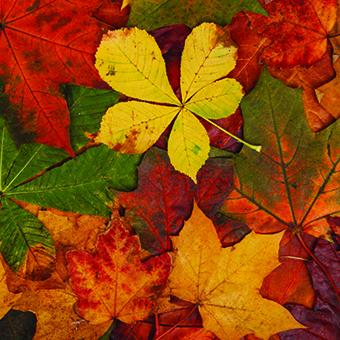
Time to Get Raking, Snipping, Trashing & Ogling the Colors
Fall cleanup should include removing all dropped leaves and stems from around garden plants. This debris could harbor fungal species that may cause powdery mildew or other diseases come next season. It is best not to compost this debris, as most compost piles will not reach a high enough temperature to kill the pathogens on any infected tissue. Should any plants appear to have diseased stems or leaves, cut them off and discard them in trash bags for removal from the property.
Under normal circumstances, most plants are not prone to disease, especially non-woody varieties. However, should any pruning be required for infected branches or stems, cuts should be made in dry weather at least a foot below tissue showing symptoms. Clean all pruning tools between cuts to prevent spreading any pathogens. Wipe blades with a 5 percent bleach solution, an alcohol spray or Lysol disinfectant. Disinfecting your tools is a good idea anytime, but especially at the very end of the season. I buy a box of individual alcohol wipes from the local pharmacy and keep them on hand with my tools for use throughout the year.
As the month of October passes, the change in colors of foliage becomes more and more apparent. With many of the larger oaks and maples, these colors can be most dramatic, especially here in the Northeast. Down below in our gardens, the change in leaf color is a bit more subtle but still lovely.
These color changes result from changes in leaf pigments, natural substances produced by the leaf cells that promote the process of photosynthesis. The most common pigment is chlorophyll, which absorbs red and blue light, reflecting other colors and making leaves look green. Another pigment in the leaves of most plants is carotene. Carotene absorbs blue-green and blue light and reflects yellow. During the growing season, chlorophyll covers the carotene so summer leaves appear green, not yellow or orange.
Another group of pigments occurring in leaves of some plants are anthocyanins. These compounds are only produced in the fall. Anthocyanins absorb blue, blue-green and green light so the light reflected by the leaves appears red. Anthocyanins exist in cell sap and are sensitive to the sap’s pH: bright red for acidic and purple for less acidic. They are formed by a reaction with sugars and certain proteins in the sap along with sunlight.
As the days become shorter, sunlight diminishes and the temperature slowly drops. Plants respond to the decreasing sunlight by producing less chlorophyll. Once the chlorophyll is no longer produced, the carotene that is also in the leaves shows through.
Low temperatures also promote the formation of anthocyanins. These anthocynanins are enhanced by bright sunshine and dry weather. Thus, bright reds are produced in dry, sunny days followed by cool, dry nights. Not all plants can make anthocyanins. In those that don’t, the yellow and brown of carotene remains the dominant color.
Note that red leaves occurring early in the season could be a sign of stress on the plant rather than a normal fall response.
The amount of rainfall during the year will also affect the autumn leaf coloring. A dry summer can delay autumn colors and a wet fall will lower their intensity. The best combination for bright autumn colors is a warm, wet spring; a summer that’s not too hot or dry; and a warm, sunny fall with cool (not freezing) nights.
For questions or comments: ron@primexgardencenter.com.

